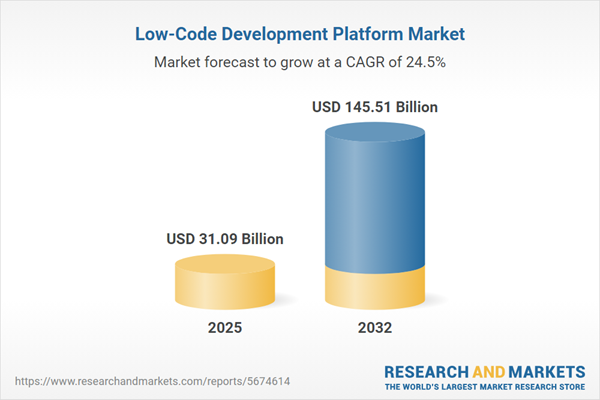Speak directly to the analyst to clarify any post sales queries you may have.
Low-code development platforms are redefining enterprise software delivery, enabling organizations to streamline digital transformation, empower cross-functional teams, and respond rapidly to changing market demands. Senior decision-makers are leveraging these platforms to enhance operational agility, accelerate innovation, and address evolving governance requirements.
Market Snapshot: Growth Trajectory in Low-Code Development Platform Market
The low-code development platform market is experiencing strong expansion, moving from USD 25.26 billion in 2024 to an estimated USD 31.09 billion in 2025, with expectations to reach USD 145.51 billion by 2032. Propelled by a robust CAGR of 24.46%, this sector is emerging as a core driver of business process modernization, digital transformation initiatives, and seamless application delivery across a wide range of industries.
Scope & Segmentation Across the Global Low-Code Platform Landscape
- Component: Platform solutions, including database, general-purpose, mobile application development, process, and request-handling; Services supporting deployment and maintenance.
- Deployment Mode: Cloud-based platforms for scalability and quick rollout; On-Premises for organizations with specialized compliance or customization needs.
- Organization Size: Large enterprises requiring complex, globally integrated capabilities; Small and Medium Enterprises focusing on usability and cost efficiency.
- Application: Mobile app creation; Web application development, each with tailored feature sets.
- Industry Vertical: Banking, Financial Services & Insurance; Education; Government & Defense; Healthcare; IT & Telecommunications; Manufacturing; Media, Entertainment & Gaming; Retail & eCommerce, each imposing unique compliance and integration demands.
- Regional Coverage: Americas (including North America and Latin America), Europe Middle East & Africa, and Asia-Pacific, reflecting distinct regulatory environments, digital maturity, and adoption patterns.
- Key Companies: Alpha Software Corporation; Appian Corporation Inc; Caspio Inc.; CREATIO EMEA LTD; Fujitsu Limited; GeneXus; Google LLC by Alphabet Inc.; Joget, Inc.; Kissflow Inc.; LANSA INC.; Magic Software Enterprises Ltd.; MatsSoft Limited by Netcall; Mendix Technology B.V. by Siemens AG; Microsoft Corporation; Netcall Technology Limited; Nintex Global Ltd.; Oracle Corporation; OutSystems company group; Pegasystems Inc.; QuickBase Inc.; Salesforce, Inc.; ServiceNow Inc.; Temenos Headquarters SA; Unqork, Inc.; WaveMaker, Inc.; Zoho Corporation.
Key Takeaways for Decision Makers
- Low-code development platforms bridge traditional coding and the need for rapid application delivery, enabling collaboration between professional developers and business users for faster time to market.
- Visual development features and prebuilt components allow organizations to adapt to changing demands without extensive specialized skills, making digital transformation more accessible across teams.
- Integrated governance and security capabilities support compliance and risk management across industries with stringent regulatory mandates, streamlining oversight within digital initiatives.
- Composable architectures and API-first approaches increase modularity, driving adoption among enterprises needing seamless integration with legacy and third-party systems.
- Market growth is shaped by regional nuances in digital maturity, regulatory landscapes, and government-led modernization efforts, which influence platform selection and deployment models.
- Strategic alliances and active developer communities accelerate innovation, enable reusable components, and support wider adoption across enterprise environments.
Tariff Impact on Supply Chain and Cost Structures
United States tariff measures have increased complexity in sourcing components for low-code platform infrastructure. These changes affect total ownership costs, especially for vendors reliant on imported servers and networking equipment. The need for localized data centers, updated procurement routes, and partnerships with logistics specialists has helped vendors offset added costs and maintain pricing consistency for customers. Adjusting supply chain strategies also enhances resilience and service continuity in a dynamic global trade environment.
Methodology & Data Sources
The insights in this report are based on structured interviews with industry practitioners, technology experts, and end users, combined with an in-depth review of public documents, vendor materials, and regulatory guidelines. Statistical analysis was applied to validate adoption and deployment patterns. Expert panels further ensured the accuracy and real-world relevance of findings.
Why This Low-Code Development Platform Market Report Matters
- Offers a comprehensive view of segmentation, technology trends, and strategic moves shaping the global low-code landscape.
- Equips senior leaders with actionable insights to optimize resource allocation and prepare for shifting compliance, integration, and deployment requirements.
- Supports informed decision-making through a rigorous research methodology and up-to-date market intelligence tailored for enterprise needs.
Conclusion
The low-code development platform market is rapidly advancing, offering organizations new avenues to strengthen operational agility and drive organizational innovation. Leaders who embrace disciplined governance, cross-functional collaboration, and strategic partnerships will unlock the market’s transformative potential and achieve sustainable growth.
Additional Product Information:
- Purchase of this report includes 1 year online access with quarterly updates.
- This report can be updated on request. Please contact our Customer Experience team using the Ask a Question widget on our website.
Table of Contents
3. Executive Summary
4. Market Overview
7. Cumulative Impact of Artificial Intelligence 2025
Companies Mentioned
The companies profiled in this Low-Code Development Platform market report include:- Alpha Software Corporation
- Appian Corporation Inc
- Caspio Inc.
- CREATIO EMEA LTD
- Fujitsu Limited
- GeneXus
- Google LLC by Alphabet Inc.
- Joget, Inc.
- Kissflow Inc.
- LANSA INC.
- Magic Software Enterprises Ltd.
- MatsSoft Limited by Netcall
- Mendix Technology B.V. by Siemens AG
- Microsoft Corporation
- Netcall Technology Limited
- Nintex Global Ltd.
- Oracle Corporation
- OutSystems company group
- Pegasystems Inc.
- QuickBase Inc.
- Salesforce, Inc.
- ServiceNow Inc.
- Temenos Headquarters SA
- Unqork, Inc.
- WaveMaker, Inc.
- Zoho Corporation
Table Information
| Report Attribute | Details |
|---|---|
| No. of Pages | 186 |
| Published | November 2025 |
| Forecast Period | 2025 - 2032 |
| Estimated Market Value ( USD | $ 31.09 Billion |
| Forecasted Market Value ( USD | $ 145.51 Billion |
| Compound Annual Growth Rate | 24.4% |
| Regions Covered | Global |
| No. of Companies Mentioned | 27 |









